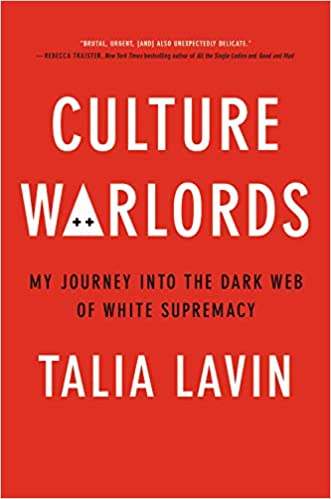
Culture Warlords
My Journey Into the Dark Web of White Supremacy
کتاب های مرتبط
- اطلاعات
- نقد و بررسی
- دیدگاه کاربران
نقد و بررسی

Starred review from August 15, 2020
A master of "social engineering" probes into the deepest recesses of White supremacism. "In order to look as deeply as I could into the world of white nationalism," writes Lavin, she has assumed a wide variety of online personas--e.g., a blond White nationalist from rural Iowa, a factory worker who regained his sense of purpose only after joining a White supremacist crew, and a seductress who broke down the electronic doors of one of the Ukraine's most virulent neo-Nazi sects. "In real life I'm a schlubby bisexual Jew," she writes, "living in Brooklyn, with long brown ratty curls, the matronly figure of a mother in a Philip Roth novel, and a brassy personal politic that's not particularly sectarian but falls considerably to the left of Medicare for All." For a full year, as she recounts in this skillful memoir, she descended into the hateful world of rightist extremism, delivering highly useful insights: For one, although White nationalist were quite happy to see Donald Trump take the presidency, he was held in suspicion for not acting beyond what they clearly see as mere encouragement and for allowing his daughter to be married to a Jew, one trope of anti-Semitism that plays on old canards but that gained power in the 20th century thanks to the likes of Henry Ford and his "vision of the Jew as world-encircling parasite, source and sustainer of the modern world's evils." The extreme right was a pioneer in computer communication, particularly because of the anonymity it offered, but Lavin's fearless hacking into the Boogaloo crowd, the women-hating incels ("none of these men have seen labia or even a penis entering a vagina," says one taunting obstetrician), and an extremely nasty 15-year-old girl whose racist rants earned a huge YouTube following have all helped expose the alt-right as a dangerous but largely pathetic bunch. Righteous indignation meets techie magic to shine light on one of America's most malignant warts.
COPYRIGHT(2020) Kirkus Reviews, ALL RIGHTS RESERVED.

October 1, 2020
Lavin takes investigative journalism to the next level by going undercover in chatrooms where discussions mainly focus on how much the participants want to harm her and others of her Jewish faith. In this book, Lavin cites some primary sources, but the majority of this narrative is a first-person account of her deep dive into far-right rhetoric, misogyny, and white-supremacy; which most of the time, in Lavin's experience, all intertwine. She discusses her experiences on chatrooms for incels, dating sites for only white subscribers, and even in-person events such as a conference for right-wing YouTubers and an anniversary event of the Unite the Right rally in Charlottesville, VA. The author often recalls what she reads and subsequently writes in these online spaces as grotesque, but she steels herself in order to expose these topics and the people who are participating in such hate. VERDICT This is a heavy read, but an important one. For readers interested in current sociopolitical events, and those wanting more insight into stories like the ones found in Seyward Darby's Sisters in Hate.--Natalie Browning, Longwood Univ. Lib., Farmville, VA
Copyright 2020 Library Journal, LLC Used with permission.

October 26, 2020
Journalist Lavin debuts with an alarming investigation into online extremism. After publishing a handful of articles on the far right, Lavin became the target of racist and misogynistic trolls who sent sexually explicit messages to her on Twitter and discussed whether she was “too ugly to rape” in a private chat room called the Bunkhouse. Unbeknownst to members of the Bunkhouse and other white nationalist websites and forums, however, Lavin, who describes herself as a “schlubby, bisexual Jew, living in Brooklyn,” was adopting fake online personas (for example, a “blonde, gun-toting” Iowan named Ashlynn) to monitor their conversations. The book also documents her infiltrations of a community of far-right “incels,” a “Neo-nazi terror propaganda cell,” and a white supremacist dating site. Lavin shares plenty of disturbing rhetoric and reveals eye-opening statistics on just how popular some of these communities are, but her analysis of the factors behind their appeal, and what can be done to stop online intolerance, doesn’t break much new ground. Still, this is a bracing and wide-ranging look at the internet as a breeding ground for racism and misogyny. Readers with a strong stomach for hateful ideology will find plenty of harrowing takeaways.

























دیدگاه کاربران